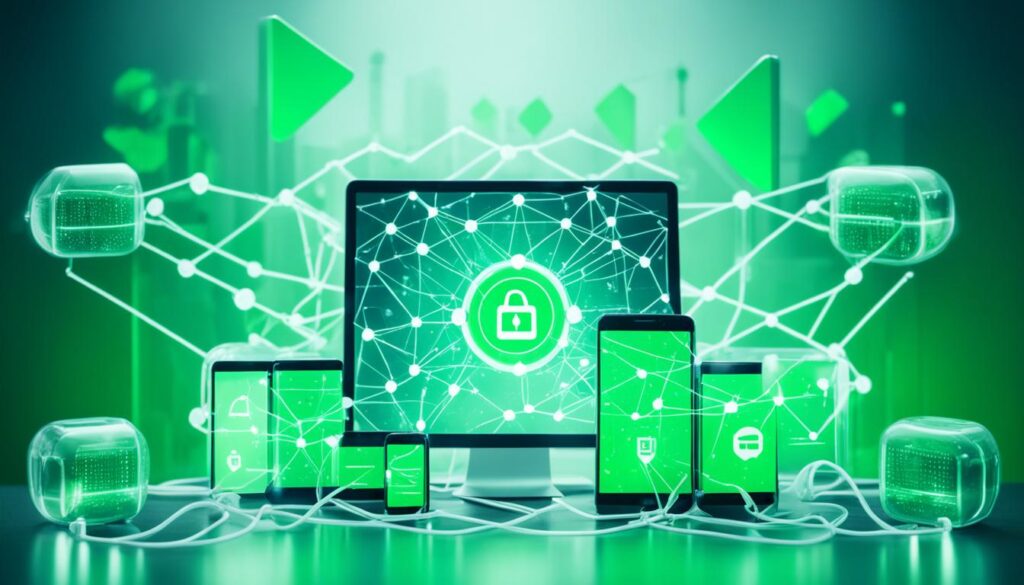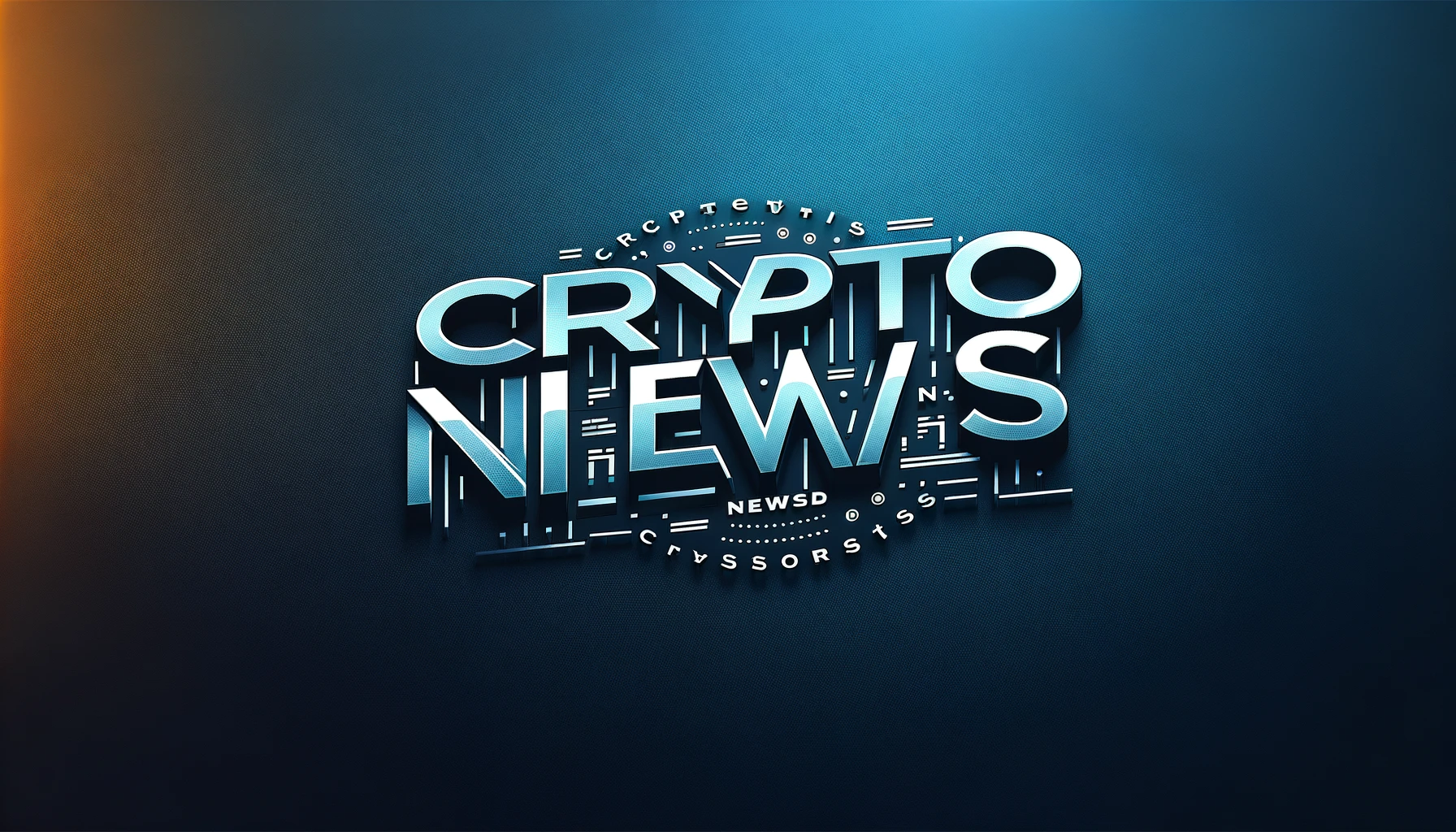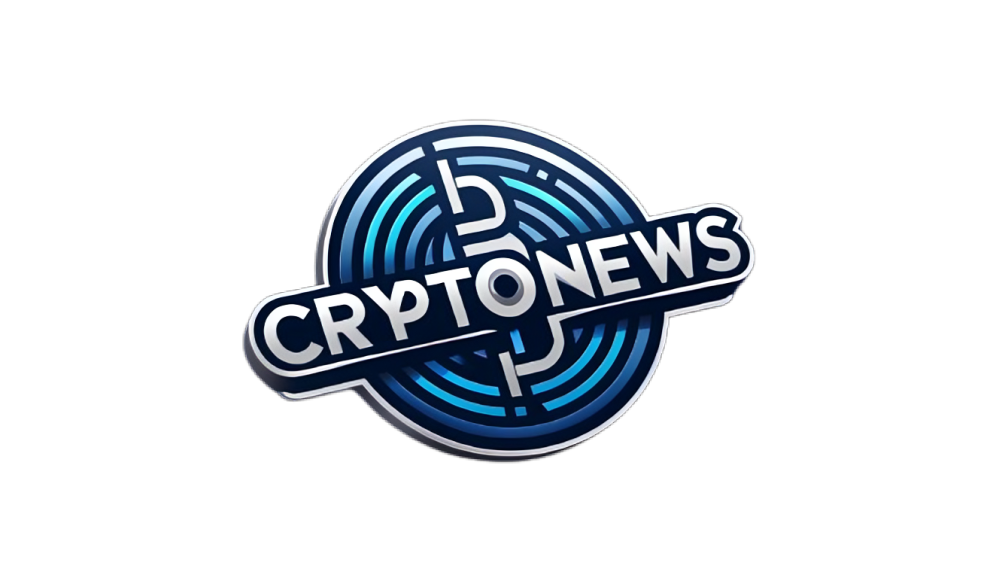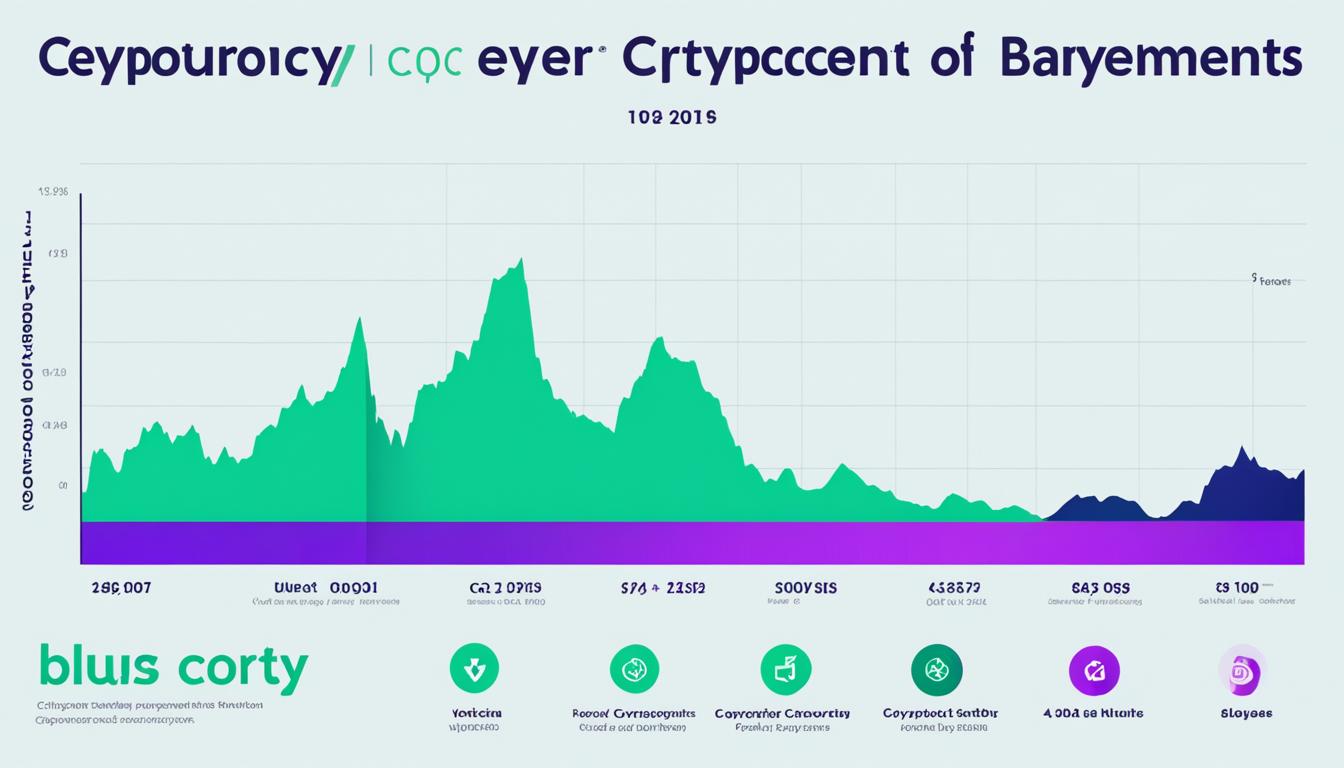Consider this: by 2025, there are expected to be more than 75 billion connected IoT devices worldwide. What’s even more astounding is the transformative role blockchain technology is earmarked to play in this expeditious growth. As blockchain and IoT converge, a new layer of functionality, security, and scalability unfolds before us. This fusion is not just a technological advancement; it’s a seismic shift, creating robust blockchain solutions for IoT connectivity that redefine how industries interact with the digital world.
Your understanding of IoT applications may already acknowledge the critical function of IoT devices in our daily lives, from smart homes to advanced manufacturing. However, integrating blockchain technology with these devices opens up a plethora of opportunities – a step towards blockchain development that champions unprecedented security and efficiency. Blockchain integration in IoT is not just a niche experiment; it represents a burgeoning ecosystem where each IoT device can benefit from enhanced IoT security and trust.
Through this exploration, you’ll discern the real power behind blockchain use cases and how blockchain solutions are ingeniously tailored to elevate IoT applications. Whether it’s tackling security uncertainties or ensuring seamless IoT connectivity, blockchain technology engenders a new level of confidence and functionality within the Internet of Things.
Contents
- 1 Demystifying Blockchain and IoT Integration
- 2 Elevating IoT Device Performance with Blockchain
- 3 Blockchain and IoT
- 4 Advancing IoT Security with Blockchain Solutions
- 5 Redefining Connectivity Through IoT Blockchain Use Cases
- 6 Overcoming IoT Challenges with Blockchain Technology
- 7 Blockchain Development and Its Role in Autonomous IoT Ecosystems
- 8 Blockchain Solutions Enabling Greater IoT Efficiency
- 9 Impact of Blockchain on Healthcare, Security, and Global Supply Chain
- 10 Conclusion
- 11 FAQ
- 11.1 What is IoT with Blockchain?
- 11.2 What are the transformative features of IBM’s Blockchain Solution for IoT?
- 11.3 How does blockchain enhance the security of IoT devices?
- 11.4 How does blockchain foster trust through immutable records?
- 11.5 How does blockchain advance IoT security?
- 11.6 How does blockchain redefine connectivity in IoT?
- 11.7 How can blockchain help overcome challenges faced by IoT?
- 11.8 What is the role of blockchain development in creating autonomous IoT ecosystems?
- 11.9 How does blockchain enable greater efficiency in IoT operations?
- 11.10 What is the impact of blockchain on healthcare, security, and global supply chains?
- 12 Source Links
Key Takeaways
- Illuminating the potential for blockchain and IoT to fundamentally reinforce IoT security in a universe of interconnected devices.
- Understanding blockchain integration as a catalyst for reliable, efficient operations within myriad IoT applications.
- Discovering real-world blockchain use cases that showcase tangible benefits for businesses and consumers alike.
- Gleaning the critical role of blockchain development in nurturing autonomous, trust-based IoT ecosystems.
- Identifying how blockchain solutions facilitate improved IoT connectivity and data integrity across sectors.
Demystifying Blockchain and IoT Integration
The confluence of Blockchain and IoT has paved the way for groundbreaking paradigms in technology application. With blockchain integration into IoT, a seamless fusion is established, allowing for a synergy that is more secure, efficient, and utterly transformative. Understanding how IoT with blockchain works and the transformative features of IBM’s blockchain solution could empower businesses to make strides in digital innovation.
What is IoT with Blockchain?
Imagine a world where your IoT devices do not just collect data but also secure it on an impenetrable digital ledger. Blockchain and IoT converge to create just that – a decentralized framework where data from IoT sensors and devices is uploaded to a blockchain, providing enhanced security and verifiability. This architecture ensures that IoT data can enjoy the full spectrum of blockchain benefits, including immutability and traceability.
Transformative Features of IBM’s Blockchain Solution
IBM’s blockchain solution epitomizes innovation within the IoT space with several transformative features. Their proprietary technology presents a solution tailored to bolster the integrity of IoT data and transactions. As industry leaders acknowledge blockchain and IoT as the future, IBM leaps forward by creating a platform that not only secures data but also instills trust among disparate network participants.
“IBM’s blockchain for IoT brings transformative features to the table. It’s an enabling technology that goes beyond conventional data sharing into realms of tamper-resistant records and trust enhancement.”
- Fosters a peer-to-peer network, negating the need for centralized control
- Endows IoT with blockchain ledger capabilities, enabling transparent and immutable records
- Enables businesses to gain operational flexibility and introduce new efficiencies
- Enhances security through sophisticated consensus algorithms and permissions
With the insights on blockchain integration provided by IBM’s blockchain solution, companies can leverage the transformative features to enhance the trust, security, and efficiency of their IoT networks.
| Feature | Description |
|---|---|
| Decentralization | Eliminates single points of failure, distributing control across a network of nodes. |
| Immutable Ledger | Ensures data once entered into the blockchain cannot be altered, bringing integrity to IoT data. |
| Enhanced Security | Leverages cryptographic techniques to protect data and transactions against unauthorized access. |
| Smart Contracts | Automates processes and agreements without human intervention, streamlining IoT operations. |
By adopting IoT with blockchain technologies, businesses stand on the cusp of a paradigm shift that promises a future of interconnected devices working in unison, securely and efficiently. Embrace these transformative features from IBM’s blockchain solution and join the vanguard of the digital revolution.
Elevating IoT Device Performance with Blockchain
The convergence of Blockchain and IoT heralds a new age of technological evolution, where IoT device performance is substantially enhanced and the paradigms of security and trust are redefined. By embedding the principles of blockchain into IoT infrastructures, stakeholders can look forward to robust systems resistant to tampering and cyber threats, thus setting a high standard for the integrity and reliability of device-generated data.
Enhanced Security for IoT Devices
IoT devices, now more than ever, demand a framework where enhanced security is not an option but a prerequisite. Blockchain’s architecture provides this by decentralizing the point of control, diluting the risks associated with centralized models. Each transaction or data exchange on a blockchain is encrypted and linked to the preceding one, crafting a chain where integrity is paramount. For IoT devices, this represents a paradigm shift, as they benefit from a network that thwarts traditional vulnerabilities while also enhancing their operational performance.
Fostering Trust through Immutable Records
Building trust among various stakeholders is a cornerstone in the realm of IoT. Blockchain’s nature of keeping immutable records engenders an environment of trust, where each stakeholder can be assured that the data has not been altered since its inception. This trust is vital for critical applications spanning from healthcare to finance, where a single data discrepancy could lead to significant consequences. Transparency and the ability to audit data effortlessly further complement trust, convincing stakeholders that embracing Blockchain and IoT together is the way forward.
| Feature | Benefits for IoT Devices |
|---|---|
| Decentralization | Reduces the risk of single points of failure and attacks. |
| Encryption & Linking | Secures data exchange, enhancing confidence in data privacy. |
| Immutability | Fosters trust in data integrity among users and stakeholders. |
| Transparency | Enables verification of device data across the network. |
| Auditability | Allows for real-time auditing, ensuring compliance and reliability. |
Blockchain propels IoT device performance into a credible and secure future. The inherent properties of blockchain induce fostering trust amongst participants and strengthening the fabric of IoT networks. The symbiosis between Blockchain and IoT not only amplifies current ecosystem virtues but also paves the way for novel applications where IoT device performance, security, and trust are not mere aspirations but tangible realities.
Blockchain and IoT
When you delve into the world of Blockchain and IoT, you are looking at a compelling fusion that holds the promise of transforming industries. The interplay between blockchain, a distributed ledger technology, and the Internet of Things, which is a network of interconnected devices, offers unparalleled opportunities for innovation. This synergy enhances transparency, security, and the management of smart devices.
The convergence of Blockchain and IoT extends beyond the theoretical, reaching practical applications that touch upon various aspects of our lives. From the way goods are tracked in supply chains to how energy consumption is monitored in smart homes, the combined impact of Blockchain and IoT is evident. The distributed nature of blockchain ensures that data from IoT devices can be securely and immutably stored, providing a layer of trust that was previously difficult to achieve.
- Decentralization of data management empowering the IoT devices to operate with robust security protocols.
- Blockchain offering a solution to IoT concerns related to privacy and data leaks, by establishing a secure and unalterable data chain.
- Smart contracts automating processes and transactions between IoT devices, reducing the need for intermediaries.
The integration of Blockchain and IoT is not without challenges, but as technology evolves, so do the solutions to these potential obstacles. Companies and developers are continually working toward more efficient methods of integrating these two technologies, recognizing their potential to initiate significant advancements in the IoT space.
“Blockchain and IoT are together reshaping the fabric of a connected world, making it more secure, transparent, and efficient.”
Advancing IoT Security with Blockchain Solutions
The fusion of blockchain technology with the Internet of Things (IoT) is poised to redefine the security paradigms across networked devices. By integrating blockchain solutions, the IoT ecosystem is becoming more resilient against sophisticated cyber threats. Let’s explore the pivotal roles blockchain plays in enhancing IoT security protocols, notably in preventing DDoS attacks and securing data through enhanced encryption methodologies.

Preventing DDoS Attacks on IoT Networks
In an era where the prevalence of IoT devices creates a dense network of connectivity, Distributed Denial of Service (DDoS) attacks have emerged as a formidable threat. Blockchain solutions disrupt these attacks by decentralizing the validation process, which fundamentally disallows the focused attack pattern that DDoS relies upon. By adopting blockchain, you are investing in a robust framework that distributes data across numerous nodes, making it incredibly challenging for attackers to disrupt the network’s operations.
Securing Data with Enhanced Encryption
Blockchain’s immutable ledger not only prevents fraudulent activities but also employs enhanced encryption strategies to secure data. Sensitive data generated by IoT devices is protected by cryptographic algorithms that blockchain employs, imbuing digital assets with a fortified shield. This means your critical information is cryptographically hashed, turning it into complex puzzles that only authorized parties can solve. This degree of encryption is vital in maintaining the confidentiality and integrity of your data as it traverses the interconnected channels of IoT networks.
| Security Feature | Advantages | Implementation in IoT |
|---|---|---|
| Decentralized Network | Reduces the risk of single points of failure, making DDoS attacks less effective | IoT data distributed across multiple nodes for resilience |
| Immutable Ledger | No alterations possible post-confirmation, enhancing trust and security | IoT device interactions and transactions are permanently recorded and verified |
| Cryptographic Hashing | Secures data through complex encryption, deterring unauthorized access | IoT data packets are encrypted, ensuring secure communication |
Redefining Connectivity Through IoT Blockchain Use Cases
The integration of blockchain technology with the Internet of Things (IoT) is pioneering a new landscape for digital connectivity. Two of the most impactful blockchain use cases in IoT revolve around enhancing supply chain transparency and enabling real-time asset tracking, essential for ensuring compliance in today’s fast-moving economy. As we explore these innovations, we understand how they contribute to redefining IoT connectivity, making operations more efficient and secure.
Supply Chain Transparency with Blockchain and IoT
One of the groundbreaking blockchain use cases in IoT is the establishment of supply chain transparency. By incorporating blockchain into supply chain management, IoT devices can now register and transfer data onto an immutable ledger. This integration not only fosters trust among stakeholders but also guarantees an unprecedented level of transparency. Stakeholders can easily verify the authenticity and status of products as they move through the supply chain in real time, leading to robust and reliable operations.
Real-Time Asset Tracking and Compliance
IoT devices equipped with blockchain technology revolutionize asset management by enabling real-time tracking. This capability is crucial in sectors where minute-by-minute tracking impacts decision-making and regulatory compliance. In scenarios ranging from transportation to healthcare, blockchains provide a secure and reliable log of asset movements, ensuring all parties adhere to local and global compliance standards. Real-time data analysis also offers opportunities for businesses to optimize logistics, reduce downtime, and prevent losses.
These interconnected blockchain use cases illustrate how businesses are pressing forward into a future where supply chains are not just connected, but are smarter, transparent, and responsive to the demands of the modern market.
Below is a detailed illustration of how blockchain enhances supply chain management and asset tracking:
| Aspect | Without Blockchain | With Blockchain and IoT |
|---|---|---|
| Data Integrity | Potentially unreliable and alterable records | Immutable and tamper-evident records |
| Transparency | Limited visibility for stakeholders | Full transparency with shared, decentralized ledger |
| Compliance | Manual checks and potential for errors | Automated compliance through smart contract enforcement |
| Real-Time Tracking | Delayed updates and response times | Immediate updates with IoT data on blockchain |
| Operational Efficiency | Dependent on centralized systems | Streamlined processes via peer-to-peer IoT networks |
In conclusion, embracing blockchain use cases in IoT results in significant advancements in supply chain management and asset tracking, enhancing operational workflows and building confidence across various industries.
Overcoming IoT Challenges with Blockchain Technology
In the rapidly evolving landscape of the Internet of Things (IoT), innovative solutions are essential for overcoming the inherent challenges that can hinder growth and performance. Blockchain technology stands out as a transformative approach, offering scalability solutions and fortifying security measures to preserve the trust and integrity of IoT systems.
Scalability Solutions for IoT Networks
Scalability challenges often impede the expansion of IoT networks, yet blockchain technology emerges as a promising paradigm to circumvent these limitations. With its decentralized structure, blockchain mitigates the dependency on centralized servers, thereby enhancing the capability of IoT systems to handle an ever-growing number of connected devices. These scalability solutions are foundational for supporting vast networks, ensuring that as IoT ecosystems expand, they maintain speed, efficiency, and reliability.
Addressing IoT Security Vulnerabilities
Blockchain technology further cements its role by addressing security vulnerabilities inherent to IoT. By design, blockchain’s distributed ledger technology makes it inherently resistant to a single point of failure, a common security challenge within IoT networks. This distributed architecture, paired with cryptographically secured transactions, ensures that data remains unaltered, instilling robust security against breaches and unauthorized tampering.

| Challenge | Blockchain Solution | Impact on IoT |
|---|---|---|
| Scalability | Decentralization | Supports more devices, faster transactions, and decentralized decision-making |
| Security | Immutable ledger & encryption | Mitigates vulnerabilities, prevents unauthorized alterations |
Through blockchain’s inventive technology, the pathway to overcoming IoT challenges becomes clearer. Its strategic implementation not only promotes scalability solutions, but it also serves as a bulwark for addressing the security vulnerabilities faced by IoT networks. As we continue to integrate this technology, the potential to empower and secure IoT infrastructures becomes increasingly tangible.
Blockchain Development and Its Role in Autonomous IoT Ecosystems
As blockchain development continues to surge, its integration within the Internet of Things (IoT) is redefining how devices interact and operate autonomously. By implementing robust blockchain protocols and fostering a services marketplace, decentralization becomes a major catalyst for enhanced system efficiency and security. Here, we delve into how these technologies are shaping the future of IoT ecosystems.
Blockchain Protocols for Interconnected Devices
Blockchain protocols are intrinsic to the fabric of IoT ecosystems, laying the digital groundwork for interconnected devices to communicate. These protocols go beyond standard security measures, ensuring not just the encryption of data but also the immutable record of transactions. Blockchain development has refined these protocols to support a myriad of actions within IoT networks, like automated decision-making and seamless peer-to-peer transactions, trailing a path towards a truly autonomous environment.
The Creation of a Services Marketplace through IoT and Blockchain
The confluence of IoT and blockchain is birthing a novel concept—a decentralized services marketplace. Here, IoT devices can autonomously offer and procure services, powered by blockchain’s trustless environment. This not only opens up a new realm for business models but also reduces inefficiencies, streamlines payment processes, and promotes transparency. From smart homes to smart cities, this integration has the potential to revolutionize how services are marketed, delivered, and consumed.
In essence, as blockchain protocols continue to evolve and the role in autonomous IoT ecosystems solidifies, we witness a streamlined and secured approach to IoT management and operation. The burgeoning services marketplace underpinned by these technologies is just one indication of the profound impact IoT and blockchain are set to have on our world.
Blockchain Solutions Enabling Greater IoT Efficiency
As the digital landscape evolves, the synergy between blockchain solutions and the Internet of Things (IoT) is creating a transformative effect on various sectors. By leveraging the robustness of blockchain, businesses are not only boosting IoT capabilities but also achieving greater IoT efficiency. This section delves into the innovative ways blockchain is enhancing IoT ecosystems.

Boosting IoT Capabilities with Smart Contracts
Blockchain empowers the IoT with smart contracts, self-executing contracts with the terms directly written into code. These smart contracts automate processes, reduce the potential for human error, and make transactions between IoT devices more secure and efficient. By codifying business rules, smart contracts are integral in boosting operational capabilities within IoT environments.
Cost Reduction by Eliminating IoT Gateways
One of the standout benefits of blockchain in IoT is cost reduction. Traditional IoT structures often rely on centralized gateways to manage and process data, which can incur significant costs and points of failure. Blockchain solutions circumvent this by eliminating the need for IoT gateways, distributing computation across the network, and reducing both the complexity and expenditure associated with maintaining these gateways.
| Aspect | With Traditional IoT Gateways | With Blockchain Integration |
|---|---|---|
| Cost | Higher due to hardware and maintenance | Reduced with decentralized networks |
| Efficiency | Dependent on central processing units | Improved with peer-to-peer communication |
| Security | Potential single points of failure | Enhanced by distributed ledger technology |
| Scalability | Limited by existing infrastructure | Flexible and adaptable structure |
In essence, the integration of blockchain solutions yields a multi-faceted approach to enhancing IoT systems. From boosting IoT capabilities with smart contracts to eliminating IoT gateways for cost-efficient operations, blockchain stands at the forefront of technological evolution, ready to redefine IoT networks.
Impact of Blockchain on Healthcare, Security, and Global Supply Chain
The transformative potential of blockchain technology extends far beyond its origins in cryptocurrency, actively redefining confidentiality and traceability in critical sectors. In the realm of healthcare, security measures, and the global supply chain, blockchain is paving the way for unprecedented improvements. Let’s examine the specific enhancements brought to data integrity and the structuring of secure supply networks.
Enhancing Healthcare Data Integrity and Privacy
One of the most significant contributions of blockchain is to healthcare, where it acts as a solid bulwark to protect data integrity and patient privacy. With blockchain’s auditable and immutable ledger, changes to medical records are transparent, fostering trust among both healthcare providers and patients. Moreover, the encryption standards employed in blockchain fortify the privacy of sensitive health data, preventing unauthorized access and securing personal information against breaches.
Creating Secure and Efficient Global Supply Networks
The global supply chain is another arena where blockchain’s impact is quite pronounced. By enhancing data integrity through an unalterable ledger, stakeholders can verify the provenance and authenticity of products without fear of counterfeit or falsified records. These secure supply networks enable seamless tracking of goods from manufacture to delivery, imparting a level of transparency and efficiency that was previously unattainable. The optimized trust and minimized vulnerabilities translate to robust security protocols, vitalizing the infrastructure of international trade.
When you reflect on the groundbreaking applications of blockchain across these fields, it is clear that the technology is instrumental in constructing the foundations for a more secure, authentic, and cooperative future. Blockchain’s impact will likely continue to grow, fostering development of systems that respect user privacy and ensure data remains unaltered and fully traceable. The opportunities for its application are boundless, promising a surge in the quality and reliability of information across these vital sectors.
Conclusion
In weaving together the myriad threads of discussion throughout this article, it becomes evident that the fusion of blockchain and IoT stands as a formidable force in modern technology. The significant impact of blockchain technology in augmenting the Internet of Things is irrefutable, presenting myriad opportunities for enhanced security, efficiency, and trust in an increasingly interconnected digital landscape. By tethering IoT devices to the robust architecture of blockchain, a new level of transparency and veracity in data exchange is achieved.
Your apprehension about the complexities of this integration should now be assuaged, as the prospects of blockchain and IoT extend far beyond theoretical musings. Across industries, this synergy is cultivating a fertile ground for innovation, mitigating prevalent security challenges, and simplifying processes that were once mired in inefficiency. It is no overstatement to say that the blockchain and IoT convergence is redefining the way that sectors such as healthcare, supply chain management, and security operate, laying the groundwork for a smarter, more reliable future.
As we stand on the brink of a technological renaissance, you are encouraged to delve deeper into the boundless opportunities presented by blockchain and IoT. In reflection, it’s clear that the marriage of these technologies is not merely an incremental step, but rather a quantum leap towards a more streamlined, secure, and interconnected world. Your ongoing exploration and engagement with these breakthroughs will undoubtedly contribute to shaping an innovative tomorrow.









Leave a Reply